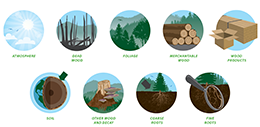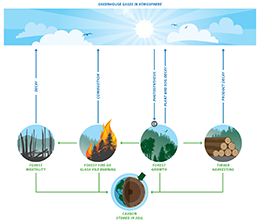Addressing Climate Change with Nature

The Intergovernmental Panel on Climate Change (IPCC) recognizes that land-based actions, such as forest management, are critical to mitigating and adapting to climate change, and are needed to keep warming well below 2°C in accordance with the Paris Agreement.
Forest carbon science and management practices are being adopted across British Columbia to reduce greenhouse gas (GHG) emissions from forests and forestry operations, while enhancing the natural carbon sinks created when forests grow.
These practices also support a variety of management objectives on provincial public land such as timber supply, habitat rehabilitation, increased rural and Indigenous Nations employment opportunities, and wildfire recovery.
What is forest carbon?
The amount of carbon stored within an ecosystem at a given time is referred to as a carbon stock. These stocks consist of different carbon pools both within the forest ecosystem, such as vegetation, soils, and dead biomass, as well as pools external to the forest, such as in wood products.
Click the image below to view an illustration of carbon stocks:

Carbon fluxes describe the transfer of carbon between pools. As trees grow they store carbon in their wood, leaves, roots, and soils. Carbon is returned to the atmosphere through decomposition or combustion, which can occur through the forest or through wood products. When forests take up more GHGs than they emit, they are referred to as carbon sinks.
Click the image below to view an illustration of carbon fluxes:
Forest carbon management practices aim to alter the fluxes of GHG emissions between managed forests and wood products with the atmosphere by increasing storage and avoiding emissions. For example, forests can be enhanced as carbon sinks through practices such as planting more trees, fertilizing stands, and minimizing losses from fires. Increasing the use of residual fibre to create wood products or generate bioenergy can also reduce emissions.

